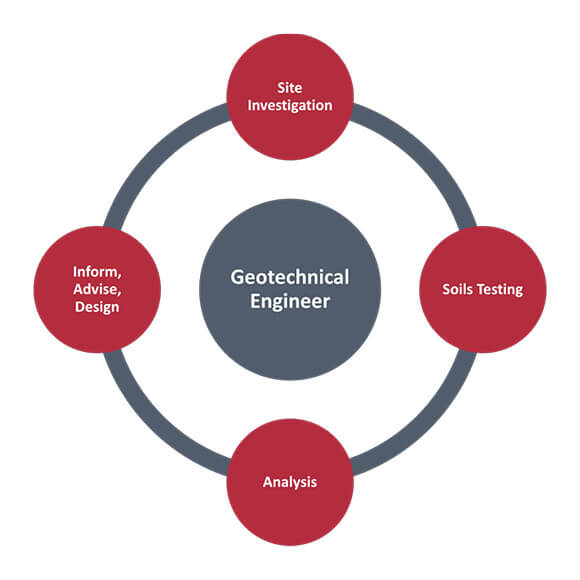Fascination About Geotechnical Engineering For Construction Projects
Table of ContentsSome Known Details About Geotechnical Engineering For Construction Projects Some Known Factual Statements About Geotechnical Engineering For Construction Projects Not known Details About Geotechnical Engineering For Construction Projects The smart Trick of Geotechnical Engineering For Construction Projects That Nobody is Talking AboutWhat Does Geotechnical Engineering For Construction Projects Do?The 3-Minute Rule for Geotechnical Engineering For Construction Projects
These features have to be taken a look at by geotechnical designers to forecast their activities under numerous conditions., making this analysis needed.A geotechnical designer will certainly examine soil to establish the bearing capacity of the earth and advise correct structure kinds, such as superficial structures, deep foundations like stacks, or specialized services like drifting foundations for soft dirts. Recognizing the features and actions of soil and rock, along with how they engage with constructions that have actually been put up on or within them, is one of the main descriptions for why geotechnical design is necessary.
Environmental security is achieved via geotechnical design. Expertise in air, water, and dirt top quality upkeep is put to use by geotechnical engineers to lessen the unfavorable effects of jobs.
To sum up, geotechnical engineering is an important discipline that preserves the resilience and honesty of civil framework. Geotechnical designers add to making structure projects reliable all over the world by comprehending the behavior of earth products and applying suitable preparation techniques.
The 2-Minute Rule for Geotechnical Engineering For Construction Projects
By analyzing soil, rock, and subsurface conditions, geotechnical designers give necessary understandings that assist in the style, construction, and maintenance of structures and framework.

Get This Report on Geotechnical Engineering For Construction Projects
Lab screening: Establishing the properties of soil and rock. Field testing: Carrying out tests on-site to examine conditions. Analysis and design: Making use of data to make structures, preserving wall surfaces, tunnels, and other frameworks. Numerous prominent building projects have effectively made use of geotechnical engineering to guarantee their stability and security. For circumstances:: The globe's highest structure needed a deep understanding of the underlying geology.

As a leader in geotechnical engineering, BECC Inc. is dedicated to providing innovative and effective services that satisfy the highest possible standards of top quality and safety and security. For additional information on just how BECC Inc. can sustain your next construction job, call us today and let us assist you improve strong ground.
William Rankine, a designer and physicist, created an alternative to Coulomb's earth pressure theory. Albert Atterberg established the clay uniformity indices that are still made use of today for soil classification. In 1885, Osborne Reynolds identified that shearing causes volumetric expansion of dense products and tightening of loose granular products. Modern geotechnical design is said to have actually started in 1925 with the magazine of Erdbaumechanik by Karl von Terzaghi, a mechanical engineer and geologist.
Indicators on Geotechnical Engineering For Construction Projects You Should Know
Terzaghi additionally created the structure for theories of bearing capability of foundations, and the concept for forecast of the rate of settlement of clay layers because of loan consolidation. After that, Maurice Biot totally established the three-dimensional soil debt consolidation theory, extending the one-dimensional model formerly created by Terzaghi to extra general theories and introducing the set of basic formulas of Poroelasticity.
Geotechnical engineers investigate and figure out the residential properties of subsurface conditions and materials. They likewise develop matching earthworks and keeping frameworks, tunnels, and structure foundations, and might supervise and review sites, which might even more include website tracking as well as the risk assessment and reduction of natural threats - Geotechnical Engineering for Construction Projects. Geotechnical designers and design geologists perform geotechnical examinations to obtain details on the physical properties of soil and rock underlying and beside a site to design earthworks and structures best site for proposed frameworks and for the fixing of distress to earthworks and structures created by subsurface conditions.
Some Known Incorrect Statements About Geotechnical Engineering For Construction Projects
Still, they are sometimes used to permit a rock hound or engineer to be lowered into the borehole for straight aesthetic and hands-on examination of the soil and rock stratigraphy. Numerous dirt samplers exist to fulfill the requirements of different engineering tasks. The standard infiltration test, which utilizes a thick-walled split spoon sampler, is one of the most usual way to accumulate disrupted samples.

Normally, the user interface's exact geometry is unidentified, and a simplified user interface geometry is thought. Limited slopes call for three-dimensional models to be analyzed, so most inclines are examined assuming that they are definitely large and can be stood for by redirected here two-dimensional versions.
Geotechnical Engineering For Construction Projects Fundamentals Explained
The empirical approach might be referred to as adheres to: General exploration sufficient to establish the harsh nature, pattern, and residential or commercial properties of down payments. Assessment of the most probable conditions and one of the most undesirable possible variances. Developing the design based on a functioning hypothesis of behavior anticipated under the most potential conditions. Selection of amounts to be observed as building proceeds and computing their expected worths based upon the working theory under the most unfavorable problems.
Dimension of amounts and examination of real conditions. Style modification per actual problems The empirical method is suitable for construction that has already started when an unforeseen development occurs or when a failing or crash looms or has actually already taken place. It disagrees for tasks internet whose style can not be changed during building and construction.